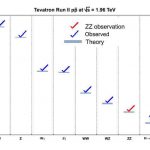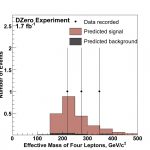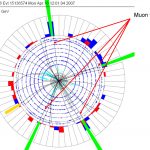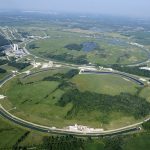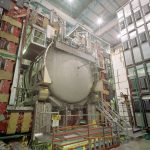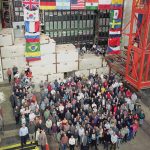Fermilab’s DZero experiment observes rare ZZ diboson production
Batavia, Ill.— Scientists of the DZero collaboration at the US Department of Energy’s Fermilab have announced the observation of pairs of Z bosons, force-carrying particles produced in proton-antiproton collisions at the Tevatron, the world’s highest-energy particle accelerator. The properties of the ZZ diboson make its discovery an essential prelude to finding or excluding the Higgs boson at the Tevatron.
The observation of the ZZ, announced at a Fermilab seminar on July 25, connects to the search for the Higgs boson in several ways. The process of producing the ZZ is very rare and hence difficult to detect. The rarest diboson processes after ZZ are those involving the Higgs boson, so seeing ZZ is an essential step in demonstrating the ability of the experimenters to see the Higgs. The signature for pairs of Z bosons can also mimic the Higgs signature for large values of the Higgs mass. For lower Higgs masses, the production of a Z boson and a Higgs boson together, a ZH, makes a major contribution to Higgs search sensitivity, and the ZZ shares important characteristics and signatures with ZH.
The ZZ is the latest in a series of observations of pairs of the so-called gauge bosons, or force-carrying particles, by DZero and its sister Tevatron experiment, CDF. The series began with the study of the already rare production of W bosons plus photons; then Z bosons plus photons; then observation of W pairs; then WZ. The ZZ is the most massive combination and has the lowest predicted likelihood of production in the Standard Model. Earlier this year, CDF found evidence for ZZ production; the DZero results presented on Friday for the first time showed sufficient significance, well above five standard deviations, to rank as a discovery of ZZ production.
“Final analysis of the data for this discovery was done by a thoroughly international team of researchers including scientists of American, Belgian, British, Georgian, Italian and Russian nationalities,” said DZero cospokesperson Darien Wood. “They worked closely and productively together to achieve this challenging and exciting experimental result.”
DZero searched for ZZ production in nearly 200 trillion proton-antiproton collisions delivered by the Tevatron. Scientists used two analyses that look for Z decays into different combinations of secondary particles. One analysis looked for one Z decaying into electrons or muons, the other decaying into “invisible” neutrinos. The neutrino signature is challenging experimentally, but worthwhile because it is more plentiful. In the even rarer mode, both Z bosons decay to either electrons or muons. Just three events were observed in this mode, but the signature is remarkably distinctive, with an expected background of only two tenths of one event.
- The discovery of ZZ production (red check mark) is an essential prelude to finding or excluding the Higgs boson at the Tevatron particle collider at DOE’s Fermi National Accelerator Laboratory. The discovery is the latest in a series of observations of so-called gauge bosons, or force-carrying particles, by DZero and its sister Tevatron experiment, CDF. The series began (from left) with the study of collisions that produced a single W or Z boson and the already rare production of a W boson plus photon; then Z boson plus photon. In the last couple of years, Tevatron experiments discovered the even rarer production of W pairs, then WZ. Now, DZero has discovered the ZZ production. The ZZ process is the final step before reaching the even rarer process of a Higgs boson decaying into a pair of W bosons.
- The DZero collaboration searched for signs for ZZ production in nearly 200 trillion proton-antiproton collisions delivered by the Tevatron. In one analysis, scientists looked for Z bosons decaying into pairs of electrons or muons. Just three events were observed in this mode. But the signature is remarkably distinctive: the predicted background is only two tenths of one event (see graph). (Note: Electrons and muons belong to a class of particles known as leptons.)
- One of the three ZZ events recorded by the DZero experiment at Fermilab: Each Z boson decayed into a pair of high-energy muons, yielding four muon tracks in the DZero detector. The green bars indicate the direction associated with each muon.
- The Fermilab accelerator complex accelerates protons and antiprotons close to the speed of light. Converting energy into mass, the Tevatron collider can produce particles that are heavier than the protons and antiprotons that are colliding. The Tevatron produces billions of proton-antiproton collisions per second, maximizing the chance for discovery. Two experiments, CDF and DZero, search for new types of particles emerging from the collisions.
- The DZero detector is about the size of a 3-story house. The detector surrounds the collision point and records the path, energy and charge of short-lived particles emerging from the collisions. Its subsystems record the “debris” emerging from high-energy proton-antiproton collisions, unveiling the forces governing the subatomic world. Tracing the particle tracks back to the center of the collision, scientists discover what processes take place at the core of proton-antiproton collisions.
- Some of the 700 scientists of the DZero collaboration in front of the DZero detector shortly before it began taking data in 2001.
Fermilab, the US Department of Energy’s Fermi National Accelerator Laboratory, located near Chicago, operates the Tevatron, the world’s highest-energy particle collider. The Fermi Research Alliance LLC operates Fermilab under a contract with DOE.
DZero is an international experiment conducted by about 600 physicists from 90 institutions in 18 countries. Funding for the DZero experiment comes from the Department of Energy’s Office of Science, the National Science Foundation, and a number of international funding agencies.
DZero collaborating institutions are at http://www-d0.fnal.gov/ib/Institutions.html




